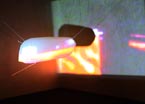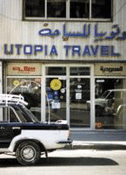December 30, 2004
Vidget 3.5

Experimental Performance Device
Vidget 3.5 is an experimental interactive audiovisual performance device which allows the user to manipulate video in real time online. As well as mixing a number of video clips together, the user may search for still images from the Flickr photo sharing site and mix them together. [via unmediated]
"...this version (Vidget 3.5) follows on from previous versions: Vidget 1; Flickr Image Viewer (Vidget 2); and Vidget 3...For instructions on Vidget 3.5 usage, see previous versions above.
Notes:
The main feature which has been fixed is the Flickr image search function. Over the last few weeks flickr.com (a very cool photo sharing site) has been changing the way they format their RSS feeds which means previous vidgets are broken. Things seem to have settled down now after a brief period of including 'enclosure' tags in their feeds I am back to parsing information from the 'description' tags for each image.
I am also back to using separate movies for the controls and output of the vidget. This improves the performance greatly as the output movie (which composites up to 3 source movies over the top of each other in real time) is rendered at 320*240 and may be increased to 640*480 by viewing at 'double size' in the Quicktime Player. I was having a lot of problems with sending the url of each of the 'source' movies from the controller movie to the output movie to be loaded. The solution was to have the output movie effectively 'ask' for the url via a custom event.
The controller movie now finds the url of the selected source movie (from either the xml file which lists the names of my clips or the Flickr RSS search response), sets it as a 'string variable' and then executes a custom event in the output movie which reads the 'string variable' back from the controller movie. The same process applies to tell the output movie which Movie In A Movie track to load the clip into.
Here's a bit of the LiveStage Pro Qscript for the controller movie:
SetStringVariable(1, channel)
SetStringVariable(2, bignumber)
SetStringVariable(4, movpath)
MovieOfID(12345).TrackNamed("Untitled Sprite").SpriteOfID(1).ExecuteEvent(42684)
The output movie then executes an event which gets these variables and sets them as 'Movie Variables':
SetString(channel, MovieOfID(838482).GetVariable(1))
SetString(bignumber, MovieOfID(838482).GetVariable(2))
SetString(movpath, MovieOfID(838482).GetVariable(4))
TrackNamed(channel).AddChildMovie(bignumber, movpath)
TrackNamed(channel).LoadChildMovie(bignumber)
Livestage Pro source files: Controller, Output"
Blogged by David Wolf
Posted by jo at 08:40 AM | Comments (0) | TrackBack
December 28, 2004
receptor-sculpture

transmitting and transmuting
Tentacle (2004) from Swedish arts collaborative Beeoff (Olle Huge, Tomas Linell and Mikael Scherdin), is a receptor-sculpture on a network that feeds streamed content (“streaming media”) over the Internet to several stations.
Tentacle gathers and transmits sound and images from nodes at distributed locations, transmitting them to a central editing computer, creating new content which is rebroadcast simultaneously back to the translucent, sculptural nodes at each location. Tentacle has been exhibted abroad in Paris (Villette Numérique), Stockholm (Splintermind – the artists’ studios) and Helsinki (Kiasma Museum), and will be exhibited for the first time in the United States at Eyebeam for their Artist in residence program.
Posted by michelle at 09:33 PM | Comments (0) | TrackBack
December 27, 2004
netzwissenschaft
![]()
Emerging Infrastructures of All (Inter)net Research
Dr. Reinhold Grether's network research | netzwissenschaft site maps the "emerging infrastructures of all (inter)net research endeavours. net.science as an anthropology of connectivity is trying to overcome the constraints of specialist method transfers on net matters. the protuberance of technical networks necessitates a professionalization of human net knowledge. neither the isolation of concepts as in basic research nor the encapsulation of processes as in applied sciences will ever be able to adequately describe the complex autopoiesis of networks. net.science is undoubtedly developing into a scienza nuova of its own right."
Check out his Mobile Art and Virtual Performance research areas.
Posted by jo at 04:45 PM | Comments (0) | TrackBack
December 10, 2004
OFFLINE

Net Jamm
Outside the frame of the exhibition and for the opening of Unzipping Codes, the net jamm performance will be led by the members of the group OFFLINE, Brian Mackern, Arcángel Consantini, and Fernando Llanos. They will mix live inputs from the internet provided by themselves or OFFLINE colleagues that will resemble a mixture of DJ and VJ procedures while revealing the unstable nature of digital reality.
OFFLINE is a cross-border global group of artist collaborators working creatively with the Internet and related digital and networked media. The purpose of OFFLINE is to bring together online art practitioners and creative technical consultants for collaborative projects staged at real world locales such as art and music festivals, symposiums, cafeterias, rooftops and city streets. OFFLINE projects will take the form of live performances, installations, and diverse experimental augmented reality displays. OFFLINE is organized via an online mailing list and a central server.
Posted by jo at 09:28 AM | Comments (0) | TrackBack
November 20, 2004
Evidence Locker

Retrieval Room
For the Liverpool Art Biennal, American Jill Magid worked with the operators of the city's CCTV surveillance cameras to teach them the techniques of professional filmmakers.
During one month, Magid wore a red trench coat and boots, ensuring she could easily be spotted throughout the city. She called the police on duty with details of where she was and asked them to film her in particular poses and even guide her through the city with her eyes closed - all using the public surveillance cameras. All around Magid, the most innocent passers-by were transformed into potential bag-snatchers, rapists and serial killers by the camera's behaviour.
The final work was made into two installations: Evidence Locker at Tate evokes the space of the CCTV monitoring station, with a soundtrack of the police log being read aloud, and CCTV footage featuring the artist. Evidence Locker at FACT reveals Magid's evolving relationship with the CCTV staff through a daily diary and video projections [until November 28th at the FACT gallery in Liverpool.] From near near future.
Posted by jo at 10:22 AM | Comments (1) | TrackBack
November 11, 2004
Utopia Travel

A Journey in Search of (post)modern Utopia
Utopia Travel is a collaborative project by Austrian Artists David Rych and Emanuel Danesch. The basis of the project is the transport of a video collection from Cairo to Vienna, following the transition from the upper part of the African continent over the Middle East towards Europe. An Egyptian taxi equipped with a video monitor served as a mobile unit distributing the contents of the video-archive on the distances between the capitol cities of the respective countries.
The title of the project was taken from the name of a travel agency in Cairo, which befittingly alluded to the ironic circumstance that tourism offers a temporary utopia of exoticism in various directions, whilst discovering no more than just a transmitted fragment of another culture. The archive contains pre-selected video material produced by artists/ film directors originating from and in most cases living in one of the countries on the route.
Every single videotape is labelled with the name of the author and title of the work. The only indication marking region on the label, is a colour code, created by melting the colours of every national flag into one. Since in certain regions (like the states of former Yugoslavia) the colours of neighbouring nations remain quite similar, differences are visible only in very subtle nuances; this makes people guess the precise origin of a work, even if the basic region was quite obvious. The method of presentation provided the opportunity to touch on a variety of issues, from the complexity of individual societies to the construction of political territories. In that sense the project is understood to be a temporary, non-institutional platform focusing on the translation and transmissibility of local cultural codes as different aspects of interrelated history.
The Archive was shown in the taxi as a mobile video installation on a three and a half months long tour through the cities Cairo, Beirut, Istanbul, Sofia, Belgrade, Sarajevo, Zagreb, Ljubljana, Graz and Vienna. The presentations took place to a large extent in public space, while also docking to different institutions for art and culture.
Posted by jo at 10:04 AM | Comments (0) | TrackBack

